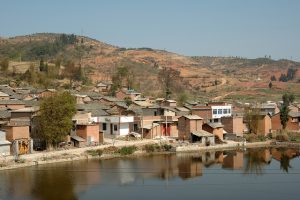The theme for this year’s International Day for the Eradication of Poverty is: Coming together
with those furthest behind to build an inclusive world of universal respect for human rights and dignity.

It serves as a reminder that people living in poverty often are disproportionately affected by human rights violations and global warming.
As climates shift and natural disasters become more common around the world, smallholder farmers and pastoralists face increasing threats to their livelihoods. The risk is particularly high in dryland regions where prolonged droughts or extreme heat can decimate crops and kill livestock. For those just barely hanging on, these shocks are enough to push them into the poverty trap. Uncertainty about what tomorrow brings further discourages farmers, rural financial services, value chain institutions and governments from investing in agriculture.
In a study released earlier this year, a group of researchers reviewed publications from the last decade to assess how agricultural production technologies and practices — for example, crop rotations — and institutional interventions — such as index-based insurance — can mitigate risk and improve farmer welfare. They found that improved crop varieties, conservation agriculture and diversified production systems can reduce adverse impacts of climate-related risk under some circumstances. Insurance and social protections can also create safety nets that enable farmers to manage risk and adopt improved technologies and practices.
The authors point out that there is limited evidence showing these interventions have helped a significant number of very poor farmers escape poverty. Further research is needed to understand what interventions, or combinations of interventions, can create impact at scale.
Learn more by reading Climate risk management and rural poverty reduction.
This work was implemented as part of the CGIAR Research Program on Climate Change, Agriculture and Food Security (CCAFS), which is carried out with support from CGIAR Fund Donors and through bilateral funding agreements. For details, please visit https://ccafs.cgiar.org/donors.
Check out other recent publications by CIMMYT researchers below:
- Viewpoint: beasts of the field? Ethics in agricultural and applied economics. 2018. Leigh Josephson, A., Michler, J.D. In: Food Policy v.79, p. 1-11.
- Analysis of spot blotch resistance and its association with yield and its related traits in bread wheat (Triticum aestivum L.) germplasm. 2018. Ritusga Tewari, Jaiswal, J.P., Kumar, A., Singh, P.K. In: The Bioscan v.11, no. 1, p. 921-924.
- Increasing yield stability and input efficiencies with cost-effective mechanization in Nepal. 2018. Park, A.G., McDonald, A., Devkota, M., Davis, A.S. In: Field Crops Research v.228, p. 93-101.
- Identification of novel quantitative trait loci linked to crown rot resistance in spring wheat. 2018. Erginbas-Orakci, G., Sehgal, D., Sohail, Q., Ogbonnaya, F.C., Dreisigacker, S., Pariyar. S.R., Dababat, A.A. In: International Journal of Molecular Sciences v. 19, no. 9, art, 2666.
- A Bayesian decision theory approach for genomic selection. 2018. Villar-Hernandez, B.d.J., Perez-Elizalde, S., Crossa, J., Perez-Rodriguez, P., Toledo, F.H., Burgueño, J. In: G3: Genes, Genomes, Genetics v.8, no. 9, p. 3019-3037.

